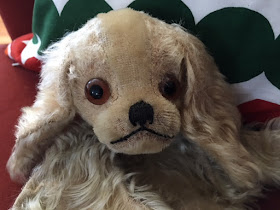The eyes have it with this marvelous Steiff creation. Steiffgal recently welcomed a rare Steiff prewar novelty into her collection... this marvelous Charly the King Charles Spaniel puppet! This darling dog has truly captured Steiffgal's heart via her irresistible expression as well as her place in the Steiff product development timeline. Admit it, you can't look away either! Come take a look at what makes this puppet such a top dog!
This happy handful is 17 cm tall, unjointed, and made from mohair. Her body, ears, arms, and face are made from longer mohair, while her muzzle is made from slightly shorter mohair. Her head is stuffed with excelsior and is lined with a cardboard finger tube. Her ears are long, floppy, and stitched lightly to the sides of her head. Her mohair has faded overall and evenly to a mellow vanilla color. When she was new, her ears and parts of her face were light brown, and the rest of her was white. Charly has three hand embroidered black claws on each of her paws; these each have a little bit of excelsior in the ends to give them some dimension. Her pouty face comes to life with oversized brown and black glass pupil eyes and a black hand embroidered nose and mouth. She retains her long trailing "f" button as her Steiff ID. Her article number is 317, which translates to 3=mohair and 17=17 cm. This lovely puppet appeared in the line from 1928 through 1939 in this size only.
This Charly puppet, of course, is a novelty based on the company's beloved and best selling prewar Charly the King Charles Spaniel. Steiff introduced Charly in the late 1920s, a time of great creativity at Steiff. The original Steiff Charly was produced both sitting and standing; the two versions were head-jointed only. Charly dogs were made from light brown or orange-tipped mohair and white mohair; had extremely long fuzzy ears; large, childlike brown and black-pupil eyes; a very detailed facial seam structure; and a prominent tail. Their filling included soft kapok, meaning that they were lighter in weight and more cuddly than other animals stuffed exclusively with excelsior. Here on the left, you can see a picture of this Charly puppet, along with a number of other charming Steiff puppets in this vignette from the company's 1929 catalog. The image is from Carsten Esser's Steiff Kataloge 1920-1929.
Knowing a good thing when they saw it, the designers at Steiff recognized that Charly would be a great source for “theme and variation” product introductions, due to her popularity with collectors. As a result, she appeared as various novelties throughout the line through 1940 or so. In addition to the puppet discussed here today, other highlights included pincushions, music boxes; tiny Nomotta woolen miniatures, a purse, and a pajama bag. Perhaps the rarest Charly of all was a Pupp Animal Doll. This version was 28 cm and dressed in a playful purple outfit. She appeared in the line only from 1929 through 1930. In 2010, a Pupp Charly realized over $8,300 at auction at Christie's in London. She is pictured here on the left; the image is from Christies.
Steiffgal hopes this discussion on Steiff's prewar Charly puppet has been a very paw-sitive experience for you.
Have a question about one of your Steiff treasures? Let's talk! Click here to learn more.


















